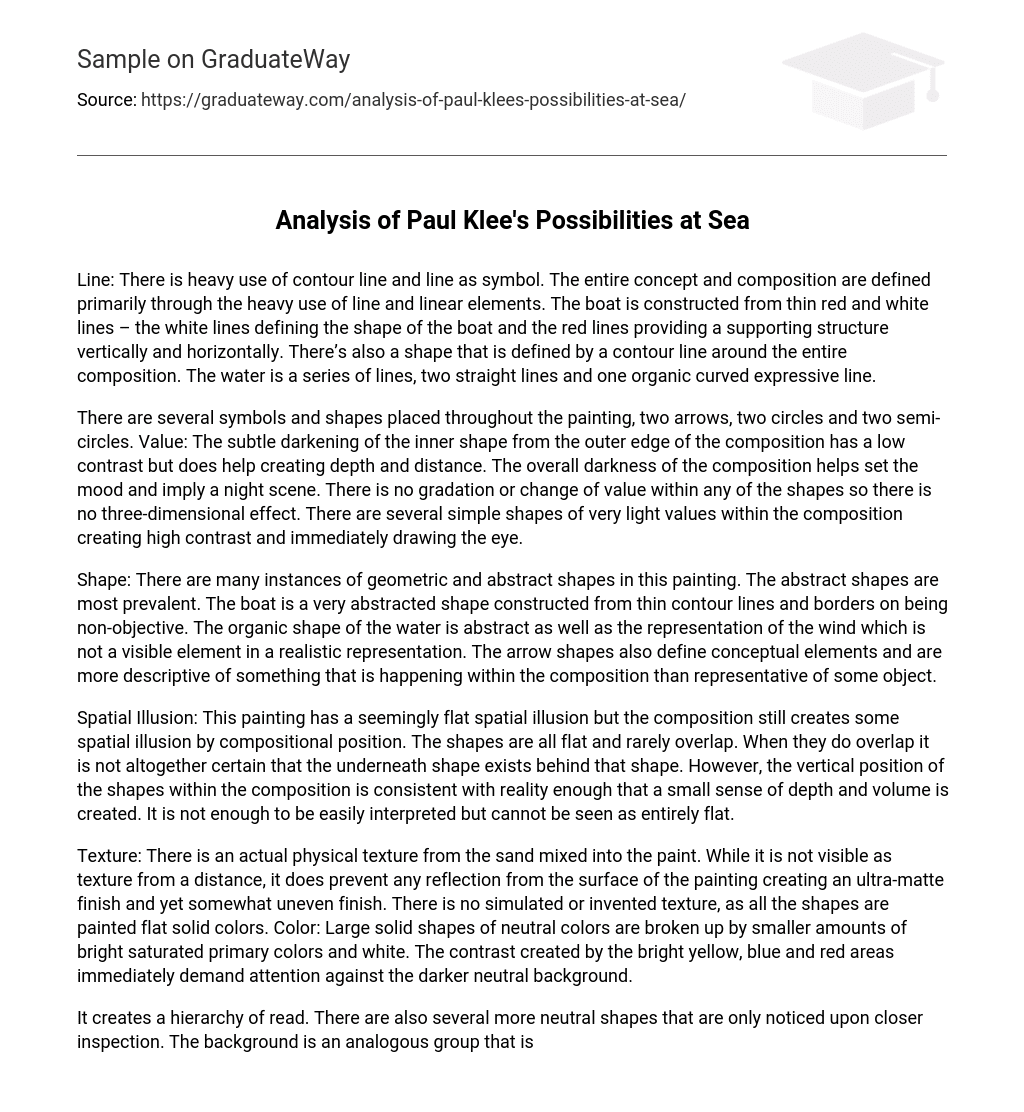There is extensive utilization of line as a symbol and contour line in the artwork. The central idea and arrangement are predominantly characterized by the abundant use of linear elements and line. The boat is created using slender red and white lines, where the white lines establish the boat’s form, and the red lines provide both vertical and horizontal support. Additionally, a contour line encircles the entire composition, delineating a distinct shape. The depiction of water consists of two straight lines and one expressive line with an organic curved nature.
Throughout the painting, there are several symbols and shapes, including two arrows, two circles, and two semi-circles. The inner shape darkens subtly from the outer edge of the composition, creating depth and distance. The overall darkness of the composition sets a mood and suggests a night scene. None of the shapes have gradation or value changes, resulting in a lack of three-dimensional effect. Additionally, there are several simple shapes with light values that create high contrast and immediately catch the viewer’s attention.
The painting contains various geometric and abstract shapes. The abstract shapes are particularly prominent, especially the boat which is depicted using thin contour lines and almost lacks any recognizable form. The water and the wind, both portrayed in an abstract manner, also contribute to the overall abstractness of the painting. Additionally, the arrow shapes serve to define conceptual elements within the composition rather than representing specific objects.
Spatial Illusion: Although this painting appears to have a flat spatial illusion, the composition cleverly generates some spatial illusion through its arrangement. All the shapes are flat and seldom overlap, and when they do, it is uncertain whether the underlying shape exists behind the other shape. However, the vertical position of the shapes within the composition aligns with reality to some extent, resulting in a slight sense of depth and volume. While it is not easily decipherable, the painting cannot be considered completely flat.
The texture of the painting is created by mixing sand into the paint, resulting in a physical texture. This texture is not easily visible from a distance but creates an ultra-matte finish with a slightly uneven surface. The painting does not contain any simulated or invented texture as all the shapes are painted with flat solid colors. In terms of color, the painting consists of large solid shapes in neutral colors with smaller amounts of bright saturated primary colors and white interspersed throughout. The contrast between the bright yellow, blue, and red areas and the darker neutral background immediately draws attention.
The text states that a hierarchy of read is established, with several subtle shapes becoming apparent upon closer inspection. The background features a harmoniously neutral group of analogous colors in terms of hue and value. The colors used in the composition convey emotions rather than depicting reality. Achromatic shapes and lines are present, as well as one shape in a shade of the primary color blue. While there is no predictable pattern of elements, there is a clear rhythm of light and dark that moves from left to right and then back from right to left.
The reason for this is the inclusion of white in the predominantly dark artwork. The main focus is on the elegant yet powerful form of the boat, particularly at the center where one of the red spars meets the outline of the white sail. This creates a convergence of three lines and almost a fourth line suggested by the black downward-pointing arrow that represents gravity.
Proportion: Despite being surrounded by the framing area, the sail boat is the largest object in the composition. Numerous secondary shapes such as those depicting water, stars, and forces of nature help clarify the subject matter of the painting. Despite its abstract nature, there is no glaring mismatch in size compared to objects found in nature. Balance: The composition exemplifies asymmetrical balance.
In the painting, there are two light value circle dots on either side. They are not evenly spaced from the point of focus, but they contribute to the balance of the composition. The addition of a black arrow above and a dark organic shape and blue horizontals below helps balance the top and bottom of the artwork. The large boat on the right is well-balanced by the light brown shape on the left. This results in overall visual balance achieved through the positioning and value of these shapes.
Visual Movement: The outer contour line of the surrounding shape contains the eye within the composition, despite its subtle contrast with the background. The two arrows’ directional focus does not push the viewer off the composition; instead, it is the balance of objects within the shape that helps guide the eye’s movement from boat to water, wind to gravity, and back to the boat. With each circuit of the painting, new elements gain importance, contributing to the overall reading and comprehension of the piece.





